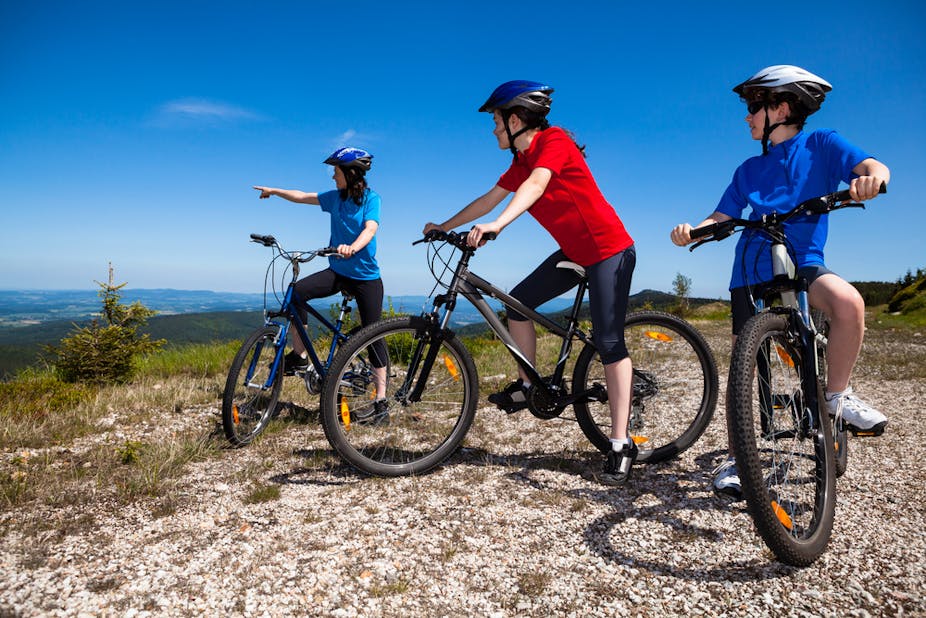Images that promote cycling in regional Victoria are often beautiful and enticing: smiling, happy people ride along scenic bike paths that meander through wide, open farmlands, dense bushland and along the coast.
But for people who live and ride in regional communities, the picture is very different.
A recent Victorian study we undertook for the Baw Baw Shire Council investigated the safety concerns of cyclists and drivers when travelling on the roads in the Baw Baw Shire area.
The study was an online survey of 283 residents in the Baw Baw Shire area, 100km east of Melbourne, the majority of whom had a driver’s licence (98.5%). Around half (47%) of respondents classified themselves as cyclists, though not all rode frequently.
The cyclist’s perspective
Cyclists were most concerned with poor road surfaces which included potholes, broken bitumen, poorly maintained sections of road and the lack of a sealed shoulder.
Poor road surface has a two-pronged impact on cyclist safety: it poses a crash hazard and, when a cyclist swerves suddenly to avoid a pothole, for example, it contributes to drivers’ perception that cyclists are unpredictable.
Cyclists were also concerned about driver attitudes and behaviours. They reported that drivers didn’t allow sufficient distance when overtaking and seemed impatient, particularly when overtaking cyclists on narrow, windy roads with poor sight lines. Cyclists also faced verbal abuse from drivers.

Cyclists and drivers generally feel more comfortable sharing the road when there are cycling-related line markings on the road. So it’s not surprising that the lack of cycling facilities (such as bike lanes) in the Baw Baw Shire area was a major safety concern for cyclists and drivers. Cyclists were also concerned that bike lanes ended abruptly with no safe option to complete their trip.
Drivers (who were infrequent cyclists or non-cyclists) reported that increased bike lanes would encourage them to ride more often as they currently felt there was no space for them on the road. Some respondents believed that a bike lane legitimised their position on the road.
The driver’s perspective
When driving, the top two concerns for all respondnets were:
- being able to overtake cyclists safely
- sharing the road on narrow road sections with no shoulder.
Beyond these two factors, the safety concerns varied considerably depending on the respondents’ road user status (cyclist or driver).
Cyclists were worried about:
- low visibility and drivers not being able to see them
- poor road surfaces
- other cyclists’ behaviour and other drivers behaviour.
Drivers reported being annoyed at bunch-riding groups that sprawled across the road, illegal or arrogant cyclist behaviour and unpredictable cyclists.
Another factor mentioned by all respondents was the issue of speed and the difference between the speed of cyclists and other road vehicles. This is not surprising given many of the roads in the Baw Baw Shire area have high speed limits, often 100km/h.
Trucks were a serious safety concern for many cyclists, particularly on narrow roads where it’s difficult to accommodate large trucks and cyclists without some compromise.
Are cyclists legitimate road users?
While the survey respondents – cyclists and drivers – saw cyclists as legitimate road users, a small percentage (1.5% of cyclists and 13.8% of drivers) didn’t. Four drivers weren’t sure.
Alarmingly, fewer than a third of participants (32.1%) thought that other drivers consider cyclists to be legitimate road users.

Council action
This study provided the Baw Baw Shire Council with quantified data about the cycling-safety concerns of residents in the area, which could be actioned.
Baw Baw Shire Council launched a six-part advertising campaign in the local newspaper to address the issue of cyclist legitimacy, driver safety and cyclist behaviour.
Brochures and stickers were also developed to promote sharing the road and these will be distributed at community and cycling events.

Signage has increased in the Baw Baw Shire area to promote cycling facilities and boost cycling legitimacy, including stencils spray painted under bike racks and local artists’ guerrilla knitting of bike parking racks.
Roadside signs to increase driver awareness of the presence of cyclists on the road have been purchased and are yet to be installed alongside the main road into Warragul, the largest township in the Baw Baw Shire.

Some 1,000 copies of the Code of Conduct for Training Cyclists have been printed for distribution to bunch riders through cycling clubs and Council.
Findings from the study have already been used to inform the Department of Transport’s Victorian Cycling Strategy of the specific cyclist safety requirements in regional areas. Discussions are continuing with Victoria Police to develop education or enforcement approaches specific to Baw Baw Shire.
The Council still has work to do in identifying routes with high volumes of cyclists along rural roads. It plans to map existing on-road bike lanes to determine whether they meet existing standards and to show the gaps in the connectedness of the current bike network.
While this study was specific to the Baw Baw Shire in Victoria, the findings can be applied to cycling in almost all regional areas of Australia. For many reasons – not least the presence of high-speed traffic, few (if any) bike lanes, poor road surfaces and lack of road shoulders – cycling in regional areas is not quite the paradise you see in tourism brochures.
With the support of local councils, studies of this kind will be the first step down the road of improved cyclist safety in regional areas.
This article was adapted from a conference paper written and presented with Nicolette Davey (Baw Baw Shire Council) this week at the 5th Annual Australian Cycling Conference.

